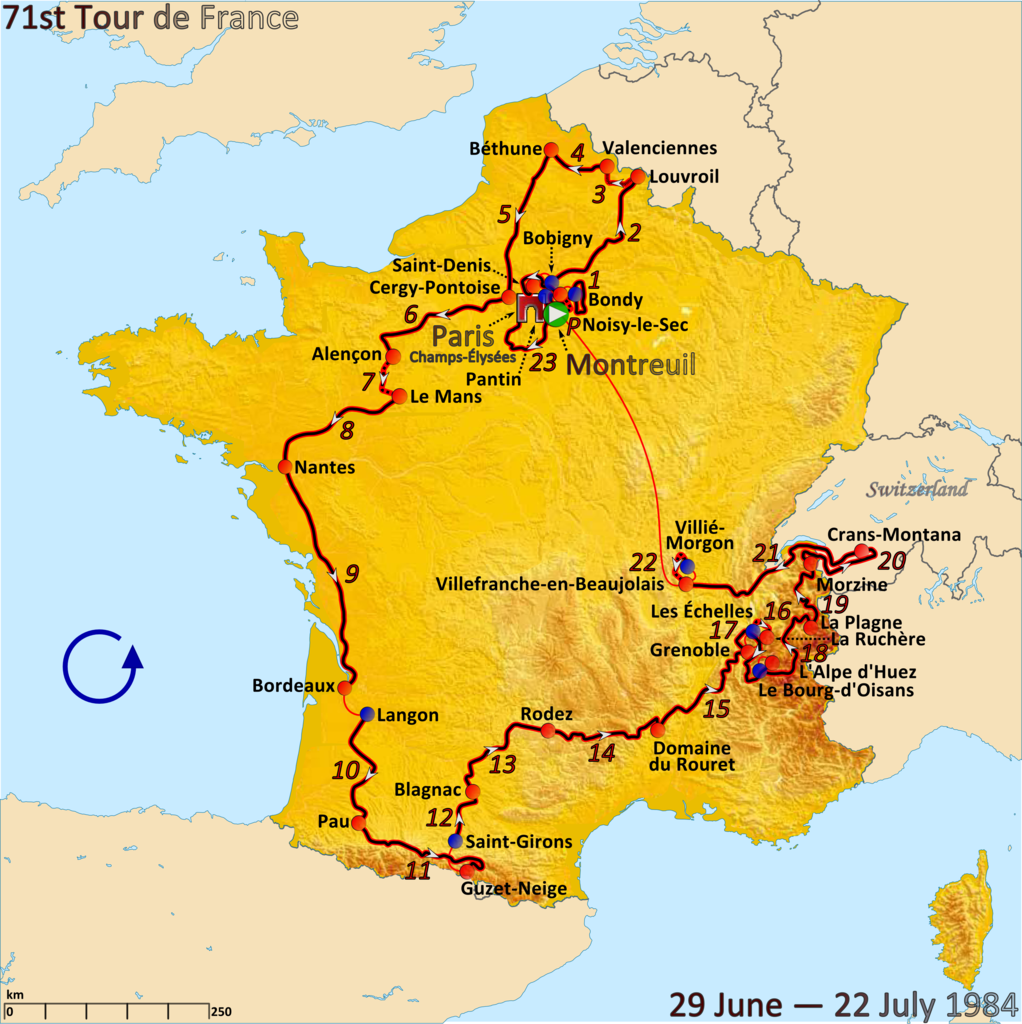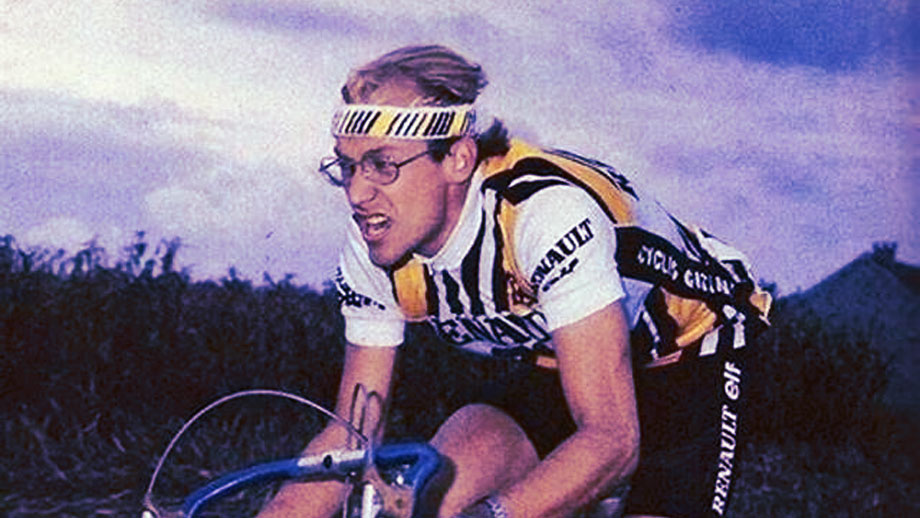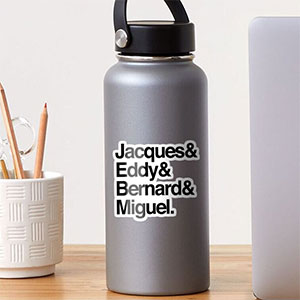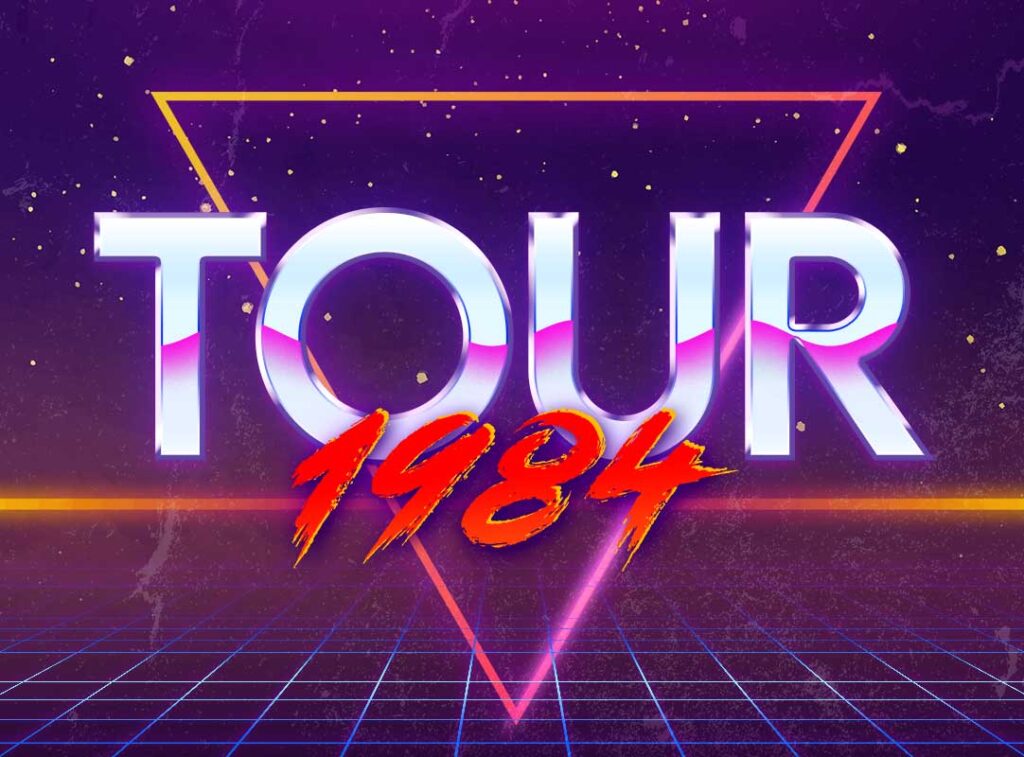
Bernard Hinault had missed out on the 1983 Tour de France due to injury, but his young domestique Laurent Fignon had taken his place in the starting line-up and, with some smart riding and strong climbing, had come away with another overall win for the team.
Was Hinault pleased? Was he fuck. Nose bent out of shape, he went on the warpath, demanding the Renault-Elf team sack directeur sportif Cyrille Guimard and renew the team with an organizational structure that would place Hinault so highly he’d be in a power-sharing agreement with God herself.
The team’s owners, pleased with Guimard’s ability to win the Tour with a person much less belligerent than Hinault, stuck on the side of Guimard and Laurent Fignon. It was probably a safe bet: Fignon looked as though he could dominate the sport for another decade.
Hinault teamed up with Look owner Bernard Tapie to form the new La Vie Claire team. He lost the national championships to Fignon and arrived at the Tour with his most notable achievement being breaking his rib in a fist fight with protestors during the Paris-Nice. Fignon led Hinault’s old team, Renault-Elf, and prepared to take his second Tour de France victory. 1984 was to be an almighty showdown.
OTHER ONES TO WATCH
It’s easy to forget that there were other riders competing in the Tour. Good ones. Pascal Simon, for example, withdrew in 1983 while leading the race, and 1983 generally had signaled the arrival of a new generation of stage racers.
Still, Fignon vs Hinault was the final fight that the entire race was building to like an 80s action movie.
Le Tour 1984

The 1984 Tour was just about par for the course for its decade. It notably brought five truly mountainous stages, four of which were back to back in the Alps in the final week of racing. It also brought five time-trials—one prologue, one team time-trial, and three individual time-trials. There was just one rest day.
Prologue to Stage Seven (29 June to 5 July)

Hinault started as he’d left off in 1982: winning the Prologue. Fignon was seconds, three seconds behind, and Allan Peiper, Phil Anderson, and Sean Yates added some Anglophone flair (?) to the top five. It was a statement of intent, but there would be more decisive opportunitiies on stages three and seven.
Two flat stages followed, won by Frank Hoste and Marc Madiot. Ludo Peters took over the race lead from Hinault, only to lose it the next day to Jacques Hanegraaf.
A team time-trial followed on Stage Three, the second real test in the war between Hinault and Fignon. Painfully for Hinault, it was Fignon who came out on top, with Hinault’s former Renault-Elf team winning the stage, and the La Vie Claire team rolling in way back in seventh place, 55 seconds down.
The TI-Raleigh team had dominated the Tour’s team time-trials for years, but they’d had their own rift, splitting into Panasonic–Raleigh and Kwantum–Decosol–Yoko. Both teams finished second and third, on the exact same time.
Hinault dropped out of the top ten. Fignon sat in sixth, and his American team mate Greg LeMond was one place ahead in fifth.
Stage Four saw Ferdi Van Den Haute solo to victory, and Adri van der Poel (returning from a strychnine ban he claimed was caused by a pigeon pie) took over the race lead. (Yes, he’s Mathieu’s dad. And also Raymond Poulidor’s son-in-law.) An unexpectedly impactful break succeeded on Stage Five, winning by nearly 20 minutes, with Paulo Ferreira taking the stage victory and Vincent Barteau moving into the race lead by around 18 minutes.
Frank Hoste got his second sprint win of the race on Stage Six. The race was distracted tough: Fignon and Hinault had their eyes on the individual time-trial the next day.
Hinault had won the prologue but Fignon had followed up in the team time-trial by putting almost a minute of distance between them. Stage Seven would settle the score. Hinault had long dominated in Tour de France time-trials, and now he had 67km from Alençon to Le Mans to assert his dominance.
But he didn’t. Fignon won the stage. Sean Kelly finished second, and Hinault rounded up the top three losing another 49 seconds to his archrival. Stephen Roche and Phil Anderson put in strong performances further down the field.
State of Play: After seven stages and one prologue, Laurent Fignon was the best of the contenders in fourth place. Hinault was sixth, a minute and a half behind Fignon. Fignon’s team mate Vincent Barteau retained the lead he’d claimed from his Stage Five break, which had reduced but still stood at just under 13 minutes from his team leader.
Frank Hoste led the points classification, which he’d taken over on Stage Five. Ludo Peeters led the mountains classification, a jersey he’d worn since Stage One.
Stages Eight to 15 (6-13 July, 1984)

Pascal Jules won an unremarkable Stage Eight by nine seconds, then an enormous 338km Stage Nine followed—the longest stage since 1967, and there still hasn’t been a stage longer since. Jan Raas won after nearly ten hours in the saddle.
Eric Vanderaerden won Stage Ten ahead of breakaway partner Marc Dierickx, but nothing changed in any classification despite the break’s two-minute lead.
ENTER THE MOUNTAINS
The 1980s Tour de Frances loved front-loading their parcours with time-trials and transition stages. They also loved holding off on decisive mountain stages until the very end of the race, with only the occasional nod to the climbers midway through. This approach to mountains has made a resurgence in recent Tours!
The mountains finally began for real on Stage Eleven, a Pyrenean stage from Pau to Guzet-Neige. Philippa York, competing as Robert Millar, won her second Tour stage with a solo attack that gave her a 41 second victory ahead of Lucho Herrera. Behind, Fignon finished in seventh place behind 1983 Tour de France runner up Angel Arroyo, and Hinault followed further behind. Fignon now sat in third place, 10 minutes and 33 seconds behind his teammate Vincent Barteau, and Hinault was in fifth, a further two minutes and five seconds behind Fignon. Jean-René Bernaudeau took over the mountains classification.
Two flat stages followed, won by Pascal Poisson and Pierre-Henri Mentheour respectively, then two rolling hilly stages in South Central France, won by Fons de Wolf and Frederic Vichot. De Wolf’s victory was a solo win by 17 minutes and 40 seconds ahead of a group of four containing Fignon and Hinault. He briefly moved up fourth place overall, one ahead of Hinault, as a result.
Frederic Vichot won the hilly Stage 15 into Grenoble and de Wolf, exhausted from the previous stage, lost all the time he’d gained and dropped out of the top ten. A rest day would follow, then a time-trial, and then four back-to-back Alpine stages that would settle the race.
State of Play: Headed into the first and only rest day, Vincent Barteau retained his lead in the overall classification after a resilient display. He led his team leader, Laurent Fignon, by 10’13” and Bernard Hinault by 12’26”. Phil Anderson, a rising star of the 1980s, was in fifth place, Greg LeMond in sixth place, and Sean Kelly in seventh.
Frank Hoste continued to lead the points classification, and Jean-René Bernaudeau led the mountains.
Rest Day (14 July, 1984)
Appropriately number one in the UK for the entire duration of the Tour.
Don’t do it! Not even if they’re in candies your grandmother brought home from Colombia.
The Race Awakens: Stages 16 to 23 (15-22 July, 1984)

And so to the final week, which would begin with a time-trial. Hinault had been bullish enough to demand a total restructuring of the Renault-Elf team, but so far he’d not only failed to get the measure of Fignon but also had to overhaul a twelve minute deficit from a different Renault-Elf rider.
Could he win his fifth Tour de France? Stage 16 is where he’d have to start, and he had just 22km to find a gap significant enough to shift the race back in his favor.
Instead, Fignon won again, 25 seconds ahead of Luco Herrera, 32 seconds ahead of Pedro Delgado, and 33 seconds ahead of Bernard Hinault. Fignon now trailed his teammate by 6’29”, and led Hinault by almost three minutes. Guimard and the Renault-Elf team appeared vindicated in backing the Professor over the Badger.
Hinault went on the offensive. The next day went from Grenoble to the Alpe d’Huez. He attacked repeatedly on the Cote de Laffrey, finally making one attack stick and opening a dangerous-looking gap of a minute on Fignon.
As he climbed the steep lower slopes of the Alpe, Hinault began to falter. Lucho Herrera, sensing the possibly of a legendary stage win, passed Hinault, and shortly afterward Fignon followed. Hinault suffered up the climb, ultimately finishing in seventh place, 3’44” behind winner Herrera and 2’55” behind Fignon. Philippa York took over the mountains lead.
When the dust had settled, Fignon had took over the race lead for the first time in 1984. Long-time race leader Barteau dropped to second, 4’22” down, and Hinault’s gap extended to 5’41”. With six stages left, the race looked to be settled.
Whether fearful of Hinault or merely looking to assert his dominance, Fignon wasn’t resting on his laurels. He soloed to victory on the mountainous Stage 18 the next day, putting 2’58” into HInault and extended his overall lead to 8’39” over HInault and 9’52” over Greg LeMond.
1983 Tour runner-up Angel Arroyo took a consolation win on Stage 19, moving up to seventh overall, with few other changes in the overall. One final mountain stage remained, Stage 20, which looked to be the penultimate chance to determine overall placements for the main contenders. But Fignon wasn’t feeling generous in the Swiss Alps. He added one more stage victory, his third (or fourth including the team time-trial), extending his lead over Hinault to 9’58”.
A rolling flat stage followed, and although a bruised Hinault bullishly competed the sprint, it was Frank Hoste who won again. Fignon won again on the following day’s time-trial, narrowly beating Sean Kelly, and extending his lead over Hinault past the ten-minute mark. Behind, Greg LeMond confirmed his third-place finish, barring disaster in the final stage. And, for all the victories Hoste had taken over the three weeks of racing, Sean Kelly’s consistent performances on all terrains meant he took over the points classification with just the final stage remaining.
ONLY GREEN REMAINS
For all the organizers’ machinations, the overall race never looked close. It was rising Anglophone talents further down the top ten who’d driven more excitement. But the green jersey is one that proved truly fascinating down to the very final pedal turns.
Sean Kelly was a veteran green jersey winner, with the capability to perform on every terrain and rack up points consistently. Frank Hoste was the fastest sprinter. Now the final sprint would decide who won the classification.
Entering the final sprint, Kelly and Hoste would duke it out on the Champs Elysees, along with a third challenger: a Bernard Hinault who wouldn’t go quietly into the night.
The winner? Oh. Eric Vanderaerden. Frank Hoste finished third, and Hinault finished fourth, one place ahead of Kelly. The Badger might not have ruined Fignon’s Tour, but he’d done enough to rob Kelly of another green jersey on the final day.
Beyond the Finish Line
LeMond announced himself on the world stage with a third-place overall finish, and Philippa York excited the British fans with an all-time best British finish of fourth place.
And upfront? Fignon won comfortably. He was the new cock of the block, dominating the race. He laughed off Hinault’s attacks as weak, and seemed assured of another decade of dominance.
Hinault, meanwhile, signed LeMond to support him the following year. Would Fignon have enough to beat the pair, or would his post-victory arrogance catch up with him?
Final Results
General Classification
Points Classification
| 1 | Frank Hoste (BEL) | Europ Decor–Boule d’Or | 322 |
|---|---|---|---|
| 2 | Sean Kelly (IRE) | Skil–Reydel–Sem–Mavic | 318 |
| 3 | Eric Vanderaerden (BEL) | Panasonic–Raleigh | 247 |
Mountains Classification
| 1 | Robert Millar (GBR) | Peugeot–Shell–Michelin | 284 |
|---|---|---|---|
| 2 | Laurent Fignon (FRA) | Renault–Elf | 212 |
| 3 | Ángel Arroyo (ESP) | Reynolds | 140 |



